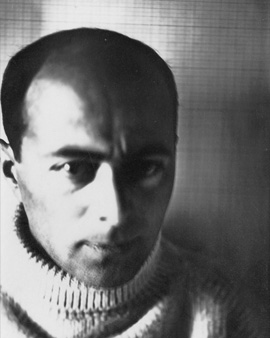Eliezer Markowich Lissitzky, known as El Lissitzky, is one of the most important representatives of Russian Costructivism and one of the most influential artists of the 20th century. His work covered a wide range of genres - from painting and architecture to typography, book art and photography. As a graphic designer in particular, he influenced various modern styles. Lissitzky also actively cultivated numerous contacts with protagonists of the Dada movement, the Bauhaus, and New Typography. Since he commuted between the Soviet Union and Germany until the end of his life, his style is marked by both Western art influences, as well as the Russian avant-garde.
Lissitzky's work is strongly marked by politics. He saw the October Revolution of 1917 as a new beginning for humanity, which he also wanted to venture in art and design. His often reproduced poster motif "Beat the Whites with the Red Wedge" clearly reflects this political attitude. This is also where the decisive design element in Lissitzky's paintings becomes apparent: the simple geometric basic form. The influence by the even more minimalist Suprematism is clearly recognizable.
Lissitzky saw his work as a coexistence of painting and architecture. This is evidenced, for example, by his experimental "Prouns," in which he expanded two-dimensional forms to include the effect of a third. As a trained architect, he also exercised various teaching activities and left the world with novel concepts in the field of exhibition design.
×





.jpg)
.jpg)
.jpg)
.jpg)
.jpg)
.jpg)
.jpg)
.jpg)
.jpg)
.jpg)
.jpg)
.jpg)
.jpg)
.jpg)
.jpg)
.jpg)
.jpg)
.jpg)
.jpg)
.jpg)
_Lissitzky_-_With_the_red_triangle_hits_the_whites_propaganda_poster_-_(MeisterDrucke-970761).jpg)
_Lissitzky_-_With_the_red_triangle_hits_the_whites_propaganda_poster_-_(MeisterDrucke-970761).jpg)
.jpg)
.jpg)
.jpg)
.jpg)
.jpg)
.jpg)
.jpg)
.jpg)
.jpg)
.jpg)
_Lissitzky_-_Untitled_-_(MeisterDrucke-1044980).jpg)
_Lissitzky_-_Untitled_-_(MeisterDrucke-1044980).jpg)
.jpg)
.jpg)
.jpg)
.jpg)
 - (MeisterDrucke-122681).jpg)
 - (MeisterDrucke-122681).jpg)
.jpg)
.jpg)
_Lissitzky_-_Lenins_tribune_architectural_design_by_el_lissitzky_(lazar_markovich_lissitzky)_-_(MeisterDrucke-1322085).jpg)
_Lissitzky_-_Lenins_tribune_architectural_design_by_el_lissitzky_(lazar_markovich_lissitzky)_-_(MeisterDrucke-1322085).jpg)
.jpg)
.jpg)
.jpg)
.jpg)
 - (MeisterDrucke-150555).jpg)
 - (MeisterDrucke-150555).jpg)
.jpg)
.jpg)
 - (MeisterDrucke-141971).jpg)
 - (MeisterDrucke-141971).jpg)
.jpg)
.jpg)
.jpg)
.jpg)
_Lissitzky_-_The_Constructor_(Selfportrait)_-_photographie_de_Lazar_Lissitskij_dit_El_Lissitz_-_(MeisterDrucke-996365).jpg)
_Lissitzky_-_The_Constructor_(Selfportrait)_-_photographie_de_Lazar_Lissitskij_dit_El_Lissitz_-_(MeisterDrucke-996365).jpg)
.jpg)
.jpg)
.jpg)
.jpg)
.jpg)
.jpg)
.jpg)
.jpg)
_Lissitzky_-_Design_drawing_for_the_proposed_wolkenbugel_(cloud-iron)_building_by_el_lissitzk_-_(MeisterDrucke-1324708).jpg)
_Lissitzky_-_Design_drawing_for_the_proposed_wolkenbugel_(cloud-iron)_building_by_el_lissitzk_-_(MeisterDrucke-1324708).jpg)
_Lissitzky_-_Proun_RVN2_-_(MeisterDrucke-1420895).jpg)
_Lissitzky_-_Proun_RVN2_-_(MeisterDrucke-1420895).jpg)
.jpg)
.jpg)
.jpg)
.jpg)
_Lissitzky_-_Design_drawing_for_the_proposed_wolkenbugel_(cloud-iron)_building_by_el_lissitzk_-_(MeisterDrucke-1324707).jpg)
_Lissitzky_-_Design_drawing_for_the_proposed_wolkenbugel_(cloud-iron)_building_by_el_lissitzk_-_(MeisterDrucke-1324707).jpg)
.jpg)
.jpg)
.jpg)
.jpg)
.jpg)
.jpg)
.jpg)
.jpg)
.jpg)
.jpg)
_Lissitzky_-_Vladimir_Maiakovski_(1893-1930)_-_Double_book_pages_from_For_the_Voice_by_Vladim_-_(MeisterDrucke-994902).jpg)
_Lissitzky_-_Vladimir_Maiakovski_(1893-1930)_-_Double_book_pages_from_For_the_Voice_by_Vladim_-_(MeisterDrucke-994902).jpg)
.jpg)
.jpg)
.jpg)
.jpg)
.jpg)
.jpg)
.jpg)
.jpg)
.jpg)
.jpg)
.jpg)
.jpg)
_Lissitzky_-_Cover_design_for_Notes_of_a_Poet_by_Ilya_Selvinsky_(1899-1968)_par_Lissitzky_El_-_(MeisterDrucke-941400).jpg)
_Lissitzky_-_Cover_design_for_Notes_of_a_Poet_by_Ilya_Selvinsky_(1899-1968)_par_Lissitzky_El_-_(MeisterDrucke-941400).jpg)
.jpg)
.jpg)
.jpg)
.jpg)
.jpg)
.jpg)
.jpg)
.jpg)
.jpg)
.jpg)
 the Bridge - (MeisterDrucke-16884).jpg)
 the Bridge - (MeisterDrucke-16884).jpg)
.jpg)
.jpg)
.jpg)
.jpg)
_-_(MeisterDrucke-1252307).jpg)
_-_(MeisterDrucke-1252307).jpg)
.jpg)
.jpg)
.jpg)
.jpg)
_Lissitzky_-_Proun_circa_1922_El_Lissitzky_(1890-1941)_-_(MeisterDrucke-1084816).jpg)
_Lissitzky_-_Proun_circa_1922_El_Lissitzky_(1890-1941)_-_(MeisterDrucke-1084816).jpg)
.jpg)
.jpg)
.jpg)
.jpg)
.jpg)
.jpg)
.jpg)
.jpg)
.jpg)
.jpg)
.jpg)
.jpg)
_Lissitzky_-_Proun_30_T_-_(MeisterDrucke-1420120).jpg)
_Lissitzky_-_Proun_30_T_-_(MeisterDrucke-1420120).jpg)
.jpg)
.jpg)
.jpg)
.jpg)
.jpg)
.jpg)
.jpg)
.jpg)
_Lissitzky_-_Victory_over_the_Sun_-_(MeisterDrucke-977241).jpg)
_Lissitzky_-_Victory_over_the_Sun_-_(MeisterDrucke-977241).jpg)
_Lissitzky_-_Proun_Watercolour_by_Lazar_Lissitskij_dit_El_Lissitskij_(Lissitsky_or_Lissitzky_-_(MeisterDrucke-946150).jpg)
_Lissitzky_-_Proun_Watercolour_by_Lazar_Lissitskij_dit_El_Lissitskij_(Lissitsky_or_Lissitzky_-_(MeisterDrucke-946150).jpg)
.jpg)
.jpg)
.jpg)
.jpg)
 - (MeisterDrucke-248703).jpg)
 - (MeisterDrucke-248703).jpg)
.jpg)
.jpg)
.jpg)
.jpg)
.jpg)
.jpg)
.jpg)
.jpg)
.jpg)
.jpg)
.jpg)
.jpg)
.jpg)
.jpg)
.jpg)
.jpg)
.jpg)
.jpg)
.jpg)
.jpg)
.jpg)
.jpg)
.jpg)
.jpg)
.jpg)
.jpg)
_from_the_Haggadah_1917_-_(MeisterDrucke-125056).jpg)
_from_the_Haggadah_1917_-_(MeisterDrucke-125056).jpg)
.jpg)
.jpg)
.jpg)
.jpg)
.jpg)
.jpg)
.jpg)
.jpg)
.jpg)
.jpg)
.jpg)
.jpg)






